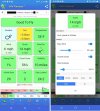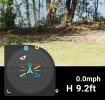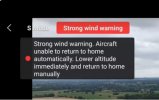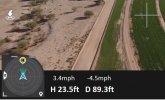I recently got a
Mini 3 Pro and been using UAV forecast (app) to see when its a good time to fly and when its not
First thing you need to do is read your User Manual and learn how Wind can affect your Drone. Not only can the wind destroy your drone, it affects its Flight Characteristics and Flight Time. If you are flying with a strong tail wind, your Drone may not have enough battery reserve to return fighting a head wind. If you are flying along in a nice slow pace (by indicated air speed), you may not realize that your Drone is flying at Maximum power just to fight that head wind and your flight time will be drastically reduced by your Drone drawing so much power from the battery just to maintain that slow pace…
If you are using the UAV App to predict Flight Conditions, then you need to setup the UAV Flight App for your particular Drone and you own aversion to flying in harsh conditions.
THE UAV App is totally User Definable; you only need to Tap the specific category. In the illustration I Tapped the "Gust" Block and the Setup Screen comes up and you define what is acceptable and what is not. The Mini does not have the wind bucking ability of the Mini SE or
Mini 2 and the they do not have the wind bucking ability of the
Mini 3. You decide what you are willing to accept. So, if you had a Mini you would set the Gusts lower than for a Mini SE and
Mini 2, and they would be set lower than the
Mini 3.

Taking your Drone's Wind-Bucking ability and your adversity to watching your little bird getting whipped around by the wind, you need to establish just how much you are willing to accept as Acceptable Gusts. Just because the UAV App says there are 35 MPH gusts in your area, perhaps your specific area is tree lined or there are adjacent hills that are blocking the wind; and it does not mean you cannot fly in those "reported Gusts…"
In the worst case, you can screw-up the setup so badly by accepting the highest or lowest values in all categories (for example 50 MPH Gusts, 100% Precipitation, Zero (0) Satellites, Zero (0) Visibility, etc…) that the App would say, "It's Good to Fly" with a Hurricane outside…
By the way, on the Satellites, you need to check your User Manual as to which of the Global Positioning Systems your Drone will receive signals. My
Mini 2 only receives the USA's GPS, Europe's Galileo, and Russia's Glonass. It does not receive China's Beidou. So I have the Beidou disabled in the UAV App…
Now how you set it up is all up to you and no two will be exactly the same. For example, you and your friend both fly the
Mini 3, but one of you has a lower threshold to the risk of damaging your Drone…
On another branch of this subject and that is the Attitude Indicator in your Fly App. It not just there to show you which way your drone is pointing nor where your drone is in relationship the Home Point nor which direction is North, nor whether you are actually facing your Drone. But it also shows you the Attitude your drone is taking in relationship to flight.
Hint, When I fly and there is the possibility of high altitude winds or Gusts that my position may not feel, I lift off to various altitudes with my Drone, facing North, and hover for a short while and I check the Attitude Indicator to see if My
mini 2 is struggling to maintain its position. This way I know if I fly in a certain direction, I'm not being blown along with a tail wind and find that I've gone too far away to recover due to the wind.

In the Attitude Indicator Graphic You will see various colored lines radiating from the Drone Icon. Your App will only show Light Gray Lines (my Drone was hovering in this screen shot with no wind so the two parallel lines radiating out at 3 and 9 o'clock indicates Level Flight).
I have added the colored lines just an exemplar to particular flight situations.
The Red Lines indicate that the Drone is dipping its nose and is either Flying forward very fast or it is fighting a very strong head wind (coming from the front).
The Blue Lines indicate that the Drone is dipping its tail and is either Flying reverse very fast or it is fighting a tail wind (coming from its tail).
The Yellow Lines indicates that the Drone is banking to the Right or it is fighting a very strong wind coming from the Right.
The Green Lines indicates that the Drone is banking to the Left or it is fighting a very strong wind coming from the Left.
And if there are No Lines visible, the tornado has it and if Dorothy finds it while she's on the Yellow Brick Road, she might bring it back if Toto doesn't think it's a Chew Toy…
So, when it comes to flying your Drone is the Wind or in Gusty Conditions, you need to use all available resources. The UAV App for a Good General Weather Condition Report, your own Good Judgement, and once you are in the air, the Attitude Indicator to tell you exactly what your Drone is Experiencing…













